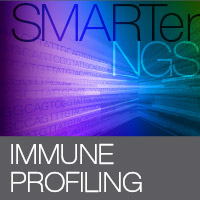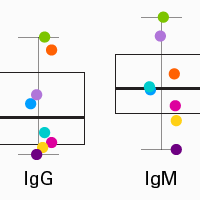Genetic basis of the T-cell repertoire
In humans and NHP, T cells are an essential component of adaptive immunity. On the surface, each T cell expresses a unique T-cell receptor (TCR) to recognize a specific antigen. Each TCR is a heterodimer. About 95% of T-cells have TCRs composed of an alpha and beta chain. The remaining 5% have TCRs composed of delta and gamma chains.
TCR are encoded by the TRA and TRB genes in the case of αβ T cells, or TRG and TRD genes in the case of ɣ∂ T cells. All of these genes are organized into clusters of segments representing the variable (V), diversity (D; TRB/TRD only), joining (J), and constant (C) regions of the TCR. Developing T cells undergo V(D)J recombination in which single V, D, J, and C gene segments are recombined into mature TRA and TRB loci (or TRG and TRD loci). From these, TCRα and TCRβ chains (or TCRɣ and TCR∂) are expressed. Each clonal population of T cells shares a clonotype, or distinguishing set of loci.
The TCR repertoire—that is, the diverse collection of clonotypes in an organism—plays a major role in shaping immune function, health, and disease progression. Over the last decade, next generation sequencing (NGS) approaches are increasingly used to profile human TRA and TRB genes. Researchers often choose to maximize information by sequencing full-length genes. For high-throughput NGS projects where speed and cost-efficiency are needed, researchers may choose to focus on the CDR3-encoding region of the TRB gene. This region, which contacts the antigen, is the most variable (Figure 1).

Figure 1. T-cell receptor structure and diversification. A functional αβ TCR heterodimer consisting of α- and β-subunit chains, with the "variable" (V), "joining" (J), and "constant" (C) segments depicted in magenta, blue, and green, respectively. The TCR-β subunit chains include these and an additional "diversity" (D) segment, depicted in orange. The CDR3 region of the TCRβ subunit is labeled.
The constant regions of the TRA and TRB genes in human and rhesus macaque share significant homology. Therefore, it is likely that tools used to track human T-cell repertoire dynamics can do the same in the rhesus macaque.
SMARTer Human TCR a/b Profiling Kit v2 chemistry
Since the recombined V(D)J segments are located in a region extending to the 5' ends of the TRA and TRB genes, capture of full RNA transcript information is essential for immune profiling. The TCRv2 kit employs SMART (Switching Mechanism at 5' end of RNA Template) technology combined with a 5'-RACE approach. This method ensures efficient incorporation of an RNA's 5'-end via the template-switching mechanism.
Briefly, the SMARTScribe Reverse Transcriptase adds a sequence of nontemplated nucleotides the 5' end of the cDNA. The TCR SMART UMI Oligo (TSUO) binds to these nontemplated nucleotides and also adds the unique molecular identifiers (UMIs). This template-switching step ensures efficient capture of the 5' end of RNA template. Full-length cDNA can be obtained by a combination of the TSUO, the highly efficient long-distance reverse transcriptase, and the use of high-integrity RNA as input.
Subsequent rounds of TCR-specific, nested PCR cycles, depicted in Figure 2, Panel A, amplify the V(D)J portions of the TRA and TRB sequences. These steps rely on primers binding to conserved sequences in the constant regions of TRA and TRB. During the PCR 2 step, unique dual indexes (UDIs) are added. Figure 2, Panel B shows a zoomed-in schematic view of these locations. Sequence homology allows TCRv2 chemistry to amplify rhesus macaque transcripts in an accurate and unbiased manner during both PCR steps.

Figure 2. SMARTer Human TCR a/b Profiling Kit v2 workflow—when rhesus macaque RNA input was used, no changes were made to accommodate the change of species. Panel A. First-strand cDNA synthesis is dT-primed and performed by the MMLV-derived SMARTScribe Reverse Transcriptase (RT), which adds proprietary nontemplated nucleotides (XXXXX) upon reaching the 5' end of each mRNA template. The TCR SMART UMI Oligo anneals to these nontemplated nucleotides, allowing it to serve as a template for the incorporation of the SMART Sequence (light green) and UMI (yellow) at the 5' end of each cDNA molecule by the RT. This is the template-switching step. The resulting cDNA then undergoes two rounds of TCR-specific PCR amplification. In the PCR 1 step, the forward primer (hTCR PCR1 Universal Forward) anneals to the SMART Sequence (light green) and adds the Read 2 sequence (dark green). The reverse primer (hTCRa/hTCRb PCR1 Reverse, orange) anneals near the 3' end of the TRA/TRB transcript, within the constant region (see details in Panel B). The PCR 2 step uses the PCR 1 product as a template. PCR 2’s forward primer has complementarity to the SMART Sequence (light green) and Read 2 sequence (dark green) and adds Unique Dual Indexes (UDIs, dark blue). PCR 2 uses semi-nested reverse primers. One reverse primer (hTCRa/hTCRb PCR2 UDI Reverse) anneals to an upstream portion (red) of the constant region relative to PCR 1’s reverse primer (orange) and it adds the Read 1 sequence (lavender). The other reverse primer has complementarity to the Read 1 sequence (lavender) and adds UDIs (dark blue). Thus, a sequencing-ready library of TRA and TRB transcripts is created. Panel B. A more detailed view shows the approximate annealing locations of all PCR 1 and PCR 2 primers within the V(D)J and constant regions of the TRA and TRB sequences. By priming from the SMART Sequence and the constant region, the PCR 1 step ensures the capture of the entire V(D)J region and specifically amplifies all TRA/TRB transcripts in an unbiased manner. The PCR 2 step further enriches TRA/TRB transcripts, adds UDIs, and decreases amplicon size, facilitating read-through on Illumina instruments. The UDIs include adapter and index sequences that are compatible with Illumina sequencing platforms and allow for multiplexing of up to 192 samples in a single flow cell lane.










